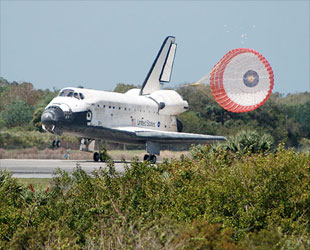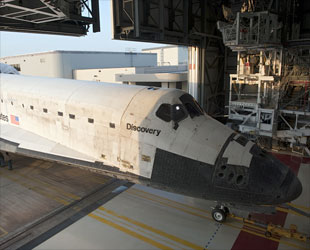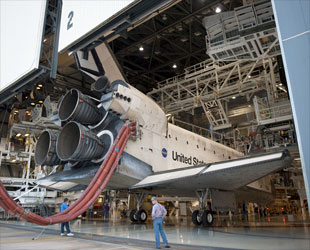March 14, 2011 — After landing back on Earth for a final time last week, space shuttle Discovery is all but officially destined for the Smithsonian. Before it can be turned over to the Washington institution however, Discovery is slated to undergo an autopsy of sorts, providing NASA engineers one last chance to learn what they can by cutting into the world's most flown spacecraft in history.
NASA's third shuttle orbiter to be built and its first to reach retirement, Discovery capped off a career total of one year aloft with the 13-day STS-133 mission, which installed the last of the pressurized modules or rooms for the U.S. side of the International Space Station (ISS). Discovery and its six crew members touched down on March 9, marking the end of Discovery's 39th and final spaceflight.
"You were able to take Discovery up to a full 365 days of actual time on orbit," radioed capcom Charles Hobaugh to STS-133 commander Steve Lindsey from Mission Control shortly after Discovery landed. "I think you would call that a fleet leader and a leader of any manned vehicle for time in orbit."

Space shuttle Discovery lands on Earth, ending the STS-133 mission, its 39th and final space flight. (collectSPACE) |
Now inside Orbiter Processing Facility-2, one of the three hangars at the Kennedy Space Center in Florida where the shuttles are prepared between missions, Discovery will at first be put through a post-flight processing flow similar to what occurred after each of its 38 earlier trips to space.
With no next launch however, the shuttle technicians who previously worked to build up Discovery for its next flight will instead tear into the shuttle to excise many of its key components for study, to save for future programs and to make the vehicle safe for public display.
"It's not as quick as you might think," said Mike Leinbach, NASA's shuttle launch director. "It is many, many months away before we'll be ready to hand [Discovery] over."
Transitioning to retirement
"We are going right into what we are calling our 'transition retirement' processing flow, which in many ways is very similar to the processing flow to get the vehicle ready for flight again. It is just this time, we are not preparing her for flight, we are preparing her for display," Stephanie Stilson, flow manager for orbiter retirement, told collectSPACE. Up until STS-133, Stilson oversaw Discovery's processing as its dedicated flow manager.

Discovery enters Orbital Processing Facility-2 at the Kennedy Space Center in Florida. (NASA) |
"The first part of that schedule is to go in and do what we call 'down mission processing,' and that is very similar to what we'd do if we were going to fly again. Every vehicle once it lands has to go through some securing and safing that has to happen right away," said Stilson.
Leinbach detailed some of the work at a press conference following Discovery's landing.
"We have to get the cryogenic [propellants] out of the fuel cell system, there are some [hypergolic fuels] we need to drain, those types of things," said Leinbach. "Pyrotechnic cartridges need to be removed. Those types of things are all very standard and that [takes] a couple of weeks."
After that work is complete, Discovery will enter a phase Stilson called "transition and retirement safing."
"In other words, to have the general public be able to be up and close and personal with Discovery, there are a lot of hazardous commodities we have to remove," explained Stilson.
According to launch integration manager Mike Moses, the systems to be stripped out of Discovery include ammonia, nitrogen tetroxide and monomethylhydrazine, all of which could pose a risk to future museum visitors if left intact.
"We have talked about do you try to just decontaminate all the lines or just remove them. In some instances, we're going to remove the plumbing," said Moses.
Detailed forensics
As Stilson and her team work to make Discovery safe for display, they will also be asked to remove components for forensic study, said Bill Gerstenmaier, NASA's associate administrator for space operations.
"We can still learn a lot from these vehicles. There are some hydraulics systems and some other things that we haven't really had a chance to have a look at because it was really too invasive to get in there and take a look at it," explained Gerstenmaier.
"So we're going to request that the teams help us pull a couple of those components out to do some real detailed forensics on so we can then learn about them for the next generation of vehicles," he said.
According to Moses, the list of hardware they want to look at is still growing, but as Gerstenmaier said, the hydraulic systems are of particular interest.
"Some of the actuators in the hydraulic systems — the flight control systems, elevons, rudder speed brake and the body flap — some of those actuators have been inline for a long time. We want to kind of tear them apart and see what condition they are in," said Moses.
"We are going to take really the best of what we have got here, learn as much as we can from this [and] archive it so when we go build the next generation [spacecraft] we'll have learned everything we can from these vehicles," said Gerstenmaier.
Reusing reusable parts
Not all the components to be removed from Discovery will be set aside for study; some will be saved to be reused in the next generation of U.S. spacecraft.
"Some of that plan is evolved [into] not so much forensics but hardware that we want to carry to the next vehicle as that next evolution of designs come forward," said Moses.

Discovery's three main engines will be removed and saved for use by NASA's next generation spacecraft. (NASA) |
"The main propulsion system elements are now items that we want to take a look at given we're going to potentially design a [next generation] propulsion system that's a little more similar to our heritage hardware."
As directed by Congress and the President, NASA's next launch vehicle may use the same main engines employed by the space shuttle, or upgraded versions of the same.
Another system being considered for reuse is the orbiter's auxiliary power units (APUs), which provide the hydraulic pressure for moving the shuttle's engines and flight control surfaces.
"The APUs, we're looking at bringing out as potential save hardware that could be 'plugged and played' in the next vehicle," said Moses, adding that a final decision has not been made. "There are still debates on the usefulness and what education we're going to get out of these pieces."
Display site decisions
Some of the decisions as to what systems will or will not be taken out of Discovery are dependent on what its next owners desire.
"It all depends on the specific display site that is getting that orbiter, so until that is decided, we haven't started negotiations as to what equipment they want," explained Moses. "Do they want it in an historical preservation? Do they want engines installed or on the side?"
"That's all [to be] ongoing negotiations once a display site is picked," said Moses.
While NASA has said since 2008 that its intentions were to give Discovery to the Smithsonian, the space agency has yet to announce the official retirement homes for any of the shuttle orbiters, Discovery included.
"There is an ongoing process," said NASA Administrator Charles Bolden while testifying March 3 before the House of Representatives' Committee on Appropriations. "It has been underway since before I became the administrator, and I kind of tweaked it when I came in."
Bolden said that while the final decision is his, he has had a team evaluating the 29 requests that NASA received to display a retired shuttle.
"I have asked that team to bring that to a head... so that I can announce a decision on the 30th anniversary of the flight of STS-1, Columbia, [on] April 12th," said Bolden.

NASA Administrator Charles Bolden, right, walks with STS-133 commander Steve Lindsey after Discovery's landing. (NASA) |
Bolden's announcement next month will clear the way for final decisions to be made and then for Stilson's team to continue onto to the third phase of Discovery's post-flight preparation.
"We then go into what we have termed the 'display site preparation.' And that will be the last chance to make any configuration changes specific to the display site," Stilson said.
"In other words, if whoever is going to have that particular vehicle wants something unique in the way of what is installed and versus what is not installed, that will give us a chance to do that and then get it ready to ferry to its final destination at the display site. Then once we get to the display site, we'll spend a couple of weeks setting up and getting it to a point where the public can then come and enjoy it."
Taking all three phases into consideration, Stilson says it will be next year before Discovery can ship (presumably) to the Smithsonian.
"We've developed a schedule which says that we should be ready to ferry Discovery most likely in January of next year," she said. "That's the schedule that we have right now. There is no hard constraint that we're working to, it's more of putting the schedule together based on the work that has to happen that we know of right now."
Were the funds available, Moses said the schedule would last longer, and the work would be more careful in regards to preserving Discovery.
"We would've loved as a program to be able to still have a budget for five or six more years to go with a fine tooth comb and open up all these systems and look and learn all these lessons. Take that hardware, preserve it."
"For example, in the propulsion systems, rather than just removing plumbing that is contaminated, decontaminate it. But that is not a cheap thing to do and just for display in a museum that's not in our charter as NASA to provide that," said Moses.
